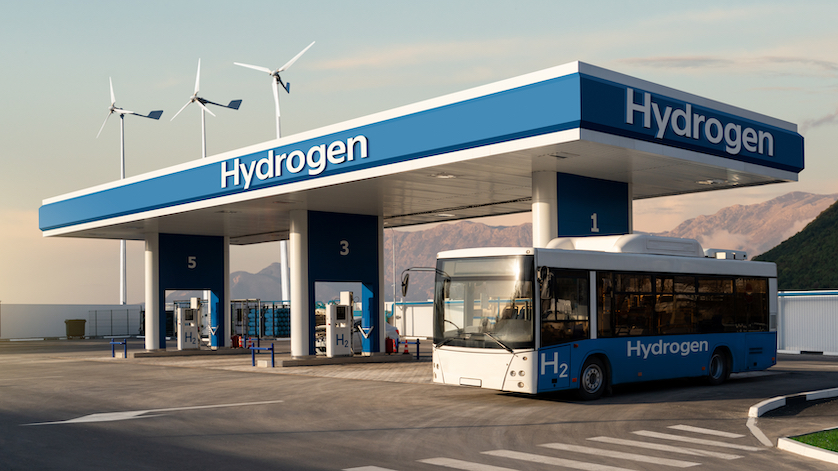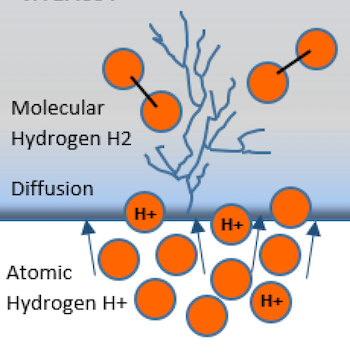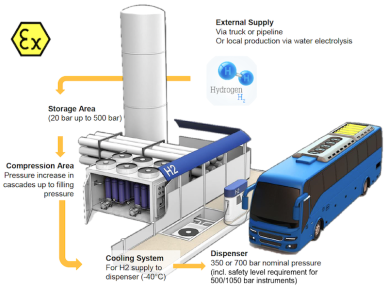
Hydrogen-powered vehicles show promise as a way to reduce greenhouse gas emissions, as refueling takes just a few minutes as opposed to several hours, and the fuel is clean. To make that vision a reality, the world needs more H2 fueling stations, which rely on hydrogen-compatible sensors, gauges, and valves for safe and reliable operations.
The market for hydrogen mobility is currently in its early stages, but all signs point to a future where hydrogen fuel cell electric vehicles (FCEVs) will share the road with battery electric vehicles (BEVs) – and one day replace the combustion engine. Developed nations around the world have begun to build the infrastructure necessary to produce, store, and transport H2, as well as to pump it into automobiles, fleet trucks, and mobile machinery.
Hydrogen Refueling Lags Behind Electric Charging… For Now
In the US but also globally, one challenge is the scarcity of hydrogen fueling stations. Although the number is rising slowly but steadily, as of September 2023 the US had just 57 retail locations: 56 in California and one in Hawaii. These numbers pale in comparison to the almost 56,000 public electric charging stations, which are found in all 50 states. (In fact, the WIKA USA headquarters in Lawrenceville, Georgia, has six Level 2 charging ports for employees and visitors.) China is currently the global leader with 250 hydrogen fueling stations, followed by Japan, South Korea, and Germany.
American lawmakers are working to increase support for hydrogen technologies as a way to reduce emissions. In March 2023, senators Chris Coons (D-Delaware) and John Cornyn (R-Texas) introduced a package of four bills to support the adoption of hydrogen in shipping ports, industry, trucking, and hydrogen infrastructure and innovation.
The private sector is also invested in H2. FirstElement Fuel is committed to creating True Zero, an extensive network of hydrogen fueling stations in California for light-, medium-, and heavy-duty vehicles. Based in Vancouver, PowerTapis strives to do the same. But rather than transporting hydrogen from a distant manufacturing facility, PowerTap produces the fuel onsite. Another innovation is portable hydrogen refueling, such as the station that Chart Industries rolled out in September 2023 using hydrogen fuel pumps by ANGI Energy Systems. Having mobile hydrogen refueling stations enables fleet owners to invest in FCEVs without having to rely on stationary locations.
How Hydrogen Fueling Stations Work
Whether the fuel pumps are stationary or mobile, the principle of hydrogen refueling stations is the same.
- After the liquefied or compressed hydrogen is trucked or piped (or the gas is produced via onsite water electrolysis), it enters a low-pressure storage cylinder or tank at a range from 290 psi (20 bar) up to 7,250 psi (500 bar).
- In preparation for filling, compressors further reduce the hydrogen’s volume for medium- or high-pressure storage, a process that raises the pressure to as high as 13,050 psi (900 bar).
- Due to compression and the Joule-Thomson effect, the gas heats up. To ensure that the hydrogen does not become too hot when dispensed, a cooling system brings the fuel’s temperature down to −40°F (−40°C) before it reaches the pump’s nozzle.
- The FCEV’s tank is filled to 350 or 700 bar (5,075 or 10,150 psi), a process that takes about as long as filling a gasoline tank. Once in the vehicle’s tank, the hydrogen is at a comfortable 86°F (30°C).
Measuring Instruments and Hydrogen: Challenges and Solutions

Hydrogen permeation and embrittlement
Measurement technologies for a hydrogen economy must overcome some hurdles, most of which have to do with the element’s unique properties.
Hydrogen permeation and embrittlement
As the smallest element, hydrogen ions can easily diffuse into most materials. Hydrogen permeation leads to embrittlement of the material. High temperatures and pressures accelerate permeation and embrittlement.
Solution: Ensure that the instrument’s wetted parts are made of hydrogen-compatible materials. A variety of alloys have an extremely tight cell arrangement that resist permeation. These include 316L (316 stainless steel with a low carbon content), 316Ti (titanium-stabilized version of 316), 2.4711 Elgiloy® (a “super alloy” of copper, chromium, nickel, and molybdenum), and other austenitic steels.
Loss of containment
Leaks result in product loss and, in worst-case scenarios, explosions. Therefore, not only should the instrument’s material be hydrogen-compatible, but so should its seals, welds, and joints.
Solution: Choose instruments with a welded adaptation of wetted components. Polymeric sealing is fine for use with most other gases and liquids, but it is too porous for hydrogen applications.
Signal offset
Hydrogen permeation can cause structural changes to the sensor element which results in signal drift which impacts the long-term reliability and accuracy of the instrument. As hydrogen fueling stations require signal stability for both safety and efficiency, only sensors made of hydrogen-resistant alloys will provide trouble-free operation and long service life.
Solution: For extra resistance to hydrogen permeation, the austenitic steel or special alloy can be coated with a metallic barrier. Gold is the most commonly requested material for plating, as this material is effective against permeation even at high temperatures.
This article continues with “Pressure and Temperature Instruments for Hydrogen Fueling Stations.”


